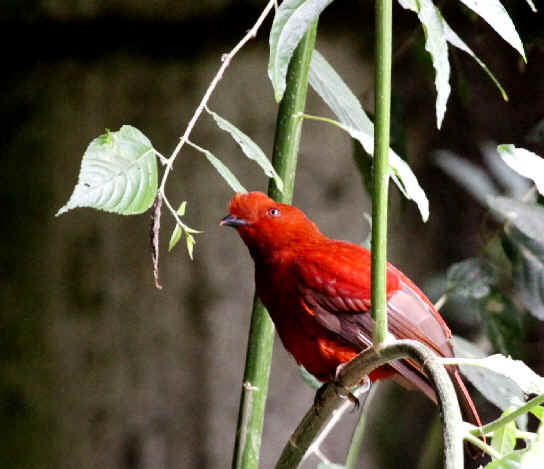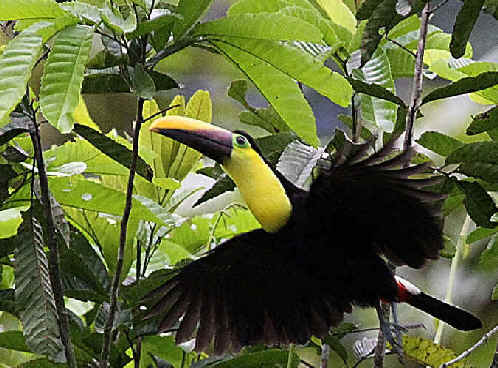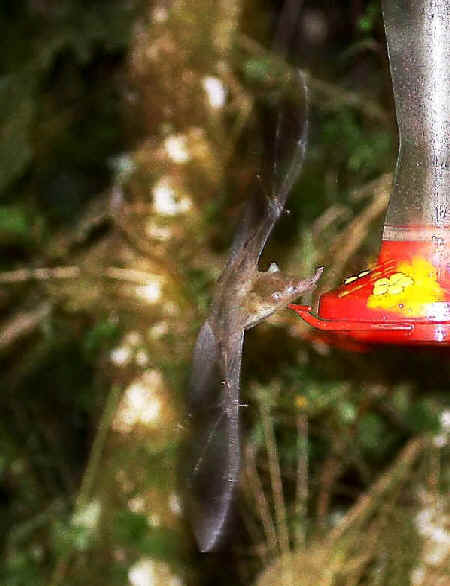
E-mail: font@focusonnature.com
Phone: Toll-free in USA 1-888-721-3555
or 302/529-1876
 |
PO Box 9021,
Wilmington, DE 19809, USA E-mail: font@focusonnature.com Phone: Toll-free in USA 1-888-721-3555 or 302/529-1876 |
Highlights
FROM SOME PREVIOUS
FOCUS ON NATURE TOURS
in ecuador

Above: a male Andean Cock-of-the-Rock,
Below: a female photographed during the FONT tour
in Ecuador in April 2013
(upper photo by Marie Grenouillet,
lower photo by Marie Gardner)

The
following summaries are with the most-recent tours first.
Click on the tour that you find of interest in the following list to go directly
to that tour summary in this file.
In the summaries, there are further links to UPCOMING TOUR ITINERARIES,
BIRD-LISTS, and PHOTO GALLERIES
Some Previous Tours:
April/May 2014
July 2013 April 2013
In all, there have been 21 FONT birding and nature tours in Ecuador.
Links:
A
List & Photo Gallery of Ecuador Birds, Part 1 of 4
(with links to Parts 2 to 4)
Hummingbirds, a List with some Photos, in 2 Parts
Rare & Threatened Birds of the Andes & Patagonia
South American Mammals (with some photos)
A List & Photo Gallery of South American Butterflies, in 6 Parts
South American Moths (with some photos)
A Photo Gallery of Ecuadorian Moths & Butterflies
Tropical Plants, a List with some Photos, in 2 Parts
Photo Galleries from FONT Ecuador Tours in: April 2013 July 2013 April/May 2014
Upcoming FONT Birding & Nature Tours in Ecuador
![]()
Ecuador
April/May 2014

One of the more than 250
species of birds
during the April-May 2014 FONT tour in Ecuador,
the Chestnut-mandibled Toucan
(photo by Marie Gardner)
Our 21st FONT tour in
Ecuador, in late-April and early-May 2014,
was in the southern and western parts of the
country.
We were, at various times during the tour, high in the Andes
Mountains, at sea level by the Pacific Ocean,
and at a number of elevations and habitats in
between.
Over 250 species of birds were found during the tour that were also quite
varied.
Among them, there was a large antpitta, that was discovered only about 15 years
previously, with a nifty Ecuadorian name, the Jocotoco Antpitta. One
morning, we saw it well.
That same morning, we heard a tapaculo that was described the same year when the
antpitta was found. Called the Chusquea Tapaculo (another unusual name),
it is scientifically called Scytalopus parkeri.
Among reasons why the Jocotoco Antpitta was not discovered until
"rather late", is that it is a rare bird with a very limited range in
the remote southern Ecuadorian forested highlands. That range is but a "dot
on the map".
Another bird during our tour also with a range that's a "dot on the
map", and also rare, actually very rare, was the Pale-headed Brush
Finch.
Only a few years ago, a mere 20 breeding pairs were known to exist. Due to the
efforts of a conservation group in Ecuador, that very small population is said
to have increased three-fold, now up to about 60 breeding pairs. That
"conservation group" in Ecuador is the
Jocotoco Foundation, named the same as the antpitta.
The foundation has established reserves in the country protecting those
two species, and others, as well as natural habitat that would most likely
otherwise be lost.
Along the seacoast, actually right along the
seacoast at the surf on the beach, there was an experience that was "right
up there" among the best during the tour.
A tight flock of Blue-footed Boobies were flying, and diving, just
offshore. There were at least a couple hundred birds. In groups, they dove like
bullets into the water. When they would rise, they would circle about, and dive
again, and again. There must have been schools with many small fish in that
water, for there to have been such a sight above the surface of the sea.
The previous day, at another coastal spot, there were also many birds, with
clouds of Magnificent Frigatebirds floating in the air, and dozens of
attractive Gray-hooded Gulls on the beach.
Seaside birding is great, anywhere.
During our two previous Ecuador tours, prior to this one, in
April and July 2013, collectively over 50 species of hummingbirds
were seen.
How nice it was that during our April/May 2014 Ecuador
Tour, yet another 13 additional species were observed.
Those seen in 2014, not seen in 2013, were: Pale-tailed Barbthroat, Green
Hermit, Violet-headed Hummingbird, Wire-crested Thorntail, Fork-tailed
Woodnymph, Violet-fronted Brilliant, Black-throated Brilliant, Rainbow
Starfrontlet, Amethyst-throated Sunangel, Flame-throated Sunangel, Black-eared
Fairy, Long-billed Starthroat, and an undescribed subspecies of the "Loja
Hummingbird" in southern Azuay province.
Most of these additional hummingbirds were seen at a place we particularly
enjoyed in far-southeastern Ecuador, on a lower Andean slope with an Amazonian
tint. That place is called Copalinga, where
in addition to the hummingbirds, we enjoyed some colorful tanagers,
including the Paradise, Green-and-gold, and Golden-eared, along
with orodendolas, caciques, two species of jays (Violaceous
and Inca), Red-headed Barbet, and a bird not commonly seen there,
a Rufous-tailed Tyrant.
Before daybreak, one morning at Copalinga, we heard two Band-bellied Owls.
To the 4-part list of Ecuadorian birds in the FONT website, we've added the code
"CP", noting species that occur at Copalinga.
To see the listing: ECUADOR BIRDS
Another place we enjoyed in 2014,
but as we did in 2013, was a Jocotoco foundation reserve called Buenaventura. There, this
time, we couldn't help but enjoy the half-dozen plus Swallow-tailed Kites
that soared about by us, sometimes at eye-level, above green forested hills in
the background.
Near that reserve, we saw 2 Bat Falcons, a male and a female, perched in
the same dead tree where we had seen them the previous year. The next day,
however, we didn't see them, in that same tree.
As said earlier, there was a varied assortment of birds during the
April/May 2014 Ecuador Tour.
There were two species of chachalacas.
There were birds as big as the Horned Screamer and as small as the Club-winged
Manakin.
Groups of Chilean Flamingos were on pools along the coast.
And there were some other rare, or threatened birds in addition to the
Jocotoco Antpitta and Pale-headed Brush Finch. Both of those
species are categorized by Birdlife International as "endangered".
Birds that we saw, categorized as "vulnerable" included the Bearded
Guan, Golden-plumed Parakeet, and the Saffron Siskin.
There's a link below to a list of the more than 250 species of birds found
during the FONT April/May 2014 tour, as
noted in southern and western Ecuador, from
the mountains to the coast.
Links:
Birds during the FONT Ecuador Tour - April-May 2014
A Photo Gallery of Birds, Scenery & Culture during the April-May 2014 FONT Ecuador Tour
A Photo Gallery of Moths & Butterflies during some FONT Ecuador Tours
And an interesting mammal was seen during the April-May 2014 FONT Ecuador Tour
in the southern part of the country.
At the same reserve, Tapichalaca, where the
Jocotoco Antpitta was seen, there
was after dark, the Tube-lipped Nectar Bat, Anoura fistulata, coming to the
hummingbird feeders that had been so active during the day with hummingbirds.
That species of bat, Anoura fistulata, was described to science only as
recently as 2005, eight years after the Jocotoco Antpitta was described, and
less than 10 years before our tour.
It inhabits subtropical Andean forest, between about 3,000 to 6,600 feet above
sea level, geographically where we were.
It is said to be endemic to Ecuador, but Peru is not far away.
The long tongue of Anoura fistulata is similar, in its anatomy, to that of an
anteater.
And that bat has what is said to be the longest known tongue of any mammal in
the world in relation to the size of the mammal. The tongue goes as far into
the animal as its ribcage.
The length of the bat is 2 inches. The length of its tongue is 3 and half
inches.
As fast as hummingbirds can be, when they visit feeders, the bats even seemed
to be faster. And of course they made their ever so-quick visits in
darkness.
But even so, the photo below, taken during our tour, shows the bat and part of
its long tongue, and provided the identification.

A Tube-lipped Nectar Bat
during the April 2014 FONT tour
in southern Ecuador
(photo by Marie Gardner)
![]()
Ecuador
July 2013
Our birding and nature
tour in Western
and Southern Ecuador in July 2013 was the 20th FONT tour in that country, and
our second tour in Ecuador in 2013.
Highlights during the tour were many, as we observed creatures from as small as
the hummingbird called the Short-tailed Woodstar (2 and a quarter inches) to as
large as the Humpback Whale (up to 50 feet long).
Over 1,100 bird species have been found during the 20 FONT tours in Ecuador over
the years.
235 species of birds were found during our July 2013 tour, with many
of them being "regional specialties".
But 2 species were found during the tour that were NOT in the book, "The
Birds of Ecuador - A Field Guide", by Robert Ridgely and Paul Greenfield,
published in 2001.
Nor were they in the 4-part "complete" list of Ecuadorian birds
in the FONT website that contains 1,632 species.
Species have been added to Ecuador country-list since the publication of the
Ridgely & Greenfield book, and they have been added diligently into that
list of 1,632 species.
Such additions have included birds such as: Dwarf Cuckoo, Panama
Flycatcher, Northern Pintail, Southern Scrub Flycatcher, Yellow-throated Vireo,
Yellow-backed Oriole, Yellow-throated Brush-Finch, White-bellied Pygmy-Tyrant,
and the recently-discovered Choco Vireo previously considered endemic to
Colombia.
But even with additions such as these, those 2 species that we found during our
July 2013 Ecuador Tour were not in the list.
The two species: the Peruvian Martin, and the Great Grebe.
A mostly dark martin (that appeared to be a "Southern Martin")
was seen by itself late in the day when we were in Salinas along what was nearly
the westernmost Ecuadorian coast. As darkness was approaching, it favored a
perch, not too far from us, on a pipe at the side of a building.
The Peruvian Martin (formerly a part of the Southern Martin) is a
species classified as "vulnerable" by Birdlife International. It
occurs along the Peruvian seacoast, not all that far, "as the martin would
fly", from the Ecuadorian coast. Our bird was photographed, although the
photos are not as good as we would
wish.
Even though there may be a question (by others) as to the ID of a darkish
martin, there can not be any as the Great Grebe we saw later during the
tour.
It is a large and distinctive bird, mostly red, with a grayish head, that has
been seen during many FONT tours in Chile, Argentina, and in the southernmost
Brazilian state of Rio Grande do Sul.
The Great Grebe , that we saw in Ecuador in July 2013, was seen at
a wonderful marsh, not far from the coast, in the southern Ecuador province of
El Oro, late in the day, with the setting sun shining on it as it swam close to
us.
We learned later that there had been a sighting of a Great Grebe, months
earlier, further north (a couple hundred kilometers) along the Ecuadorian
seacoast.
Other avian highlights during our tour included one bird of only two
pairs of Waved Albatross nesting on an offshore Ecuadorian island,
where also we enjoyed walking among both Blue-footed and Nazca Boobies.
On another day, during a most enjoyable and productive bird-walk in a dry forest
in western Ecuador, late in the morning, we
saw, in addition to many other birds, two species of owls: a Pacific
Pygmy Owl and a Tumbes Screech Owl.
In an area with forested hills in southern Ecuador
we were thrilled early one morning to see and hear a male Long-wattled
Umbrellabird.
Also in that area, we were continuously thrilled to see a frenzy of bird
activity at feeders at a lodge where we stayed. That lodge was named after
the umbrellabird.
The frenzy was of birds, many of which were hummingbirds (at least 50 at
any given time), along with honeycreepers, tanagers, bananaquits, and
larger birds such as aracaris and chachalacas. Being there, with
so many birds, was, for us, a delight.
And, at that same spot, it was also exciting after dark, where (as a
Black-and-white Owl either sat on a distant limb, or called in the woods),
there was yet another frenzy - of moths, as dozens of them,
with an array of sizes, shapes, and colors, came into the lights.
In all, we had, from start to finish, a great tour!
Links:
More about the FONT Ecuador Tour in July 2013
Birds during the FONT Ecuador Tour - July 2013
A Photo Gallery of Birds, Mammals, Scenery & Culture during the July 2013 FONT Ecuador Tour
A Photo Gallery of Moths & Butterflies during some FONT Ecuador Tours
![]()
Ecuador
April 2013
In Ecuador,
during the FONT tour in April 2013, we saw
birds, many of them. Nearly 300 species.
So many were hummingbirds. Over 40 species. Many, with their iridescence, were colorful.
All were fast as they flew. Many were distinctive, some with long tails, and one
with a long, very long bill.
During our April 2013 Ecuador Tour, surely we saw the most hummingbirds ever
seen during any FONT tour,
for both the numbers of individuals and species seen.
And the most antpittas - and among them, a number seen very well,
including the Moustached, Ochre-breasted, Rufous, and Tawny.
Antpittas can be hard to see. As can be tapaculos. During our
April 2013 Ecuador Tour we enjoyed a great look at one of the largest and most
boldly-patterned in that family, the Ocellated Tapaculo.
A spectacular bird, for us, was the Andean Cock-of-the-Rock. We saw a
female before she flew to her nest, and the following morning we encountered a
group of males as they noisily flew about at their lek.
Other birds we saw with the adjective "Andean" included the
rarely-seen Andean Potoo, the Andean Gull and Andean Lapwing,
and the biggest of all, the Andean Condor.
At one time and place, we saw what has been for FONT, the biggest number of Andean
Condors, as many as 21, concentrated on a field apparently partaking in a
meal.
That was an experience in the high Andean mountains of Ecuador never to be
forgotten.
The Andean Potoo was one of two species of potoos during our tour. Twice,
Common Potoos were seen, as still as could be, camouflaged as branches
during the day.
An unusual experience for all of us was seeing another nocturnal bird, the Oilbird,
sitting by day on ledges in a narrow cave-like chasm.
Others in the avian cast of characters during our April 2013 tour in Ecuador,
included a good assortment of toucans, tanagers, trogons, and
manakins, barbets, woodpeckers and woodcreepers, and wrens,
euphonias, conebills, and flower-piercers.
All of the birds mentioned here made, of course, for a most enjoyable birding tour.
Links:
More about the FONT Ecuador Tour in April 2013
Birds during the FONT Ecuador Tour - April 2013
A Gallery of Photos from the April 2013 FONT Ecuador Tour
![]()